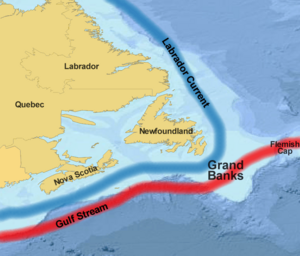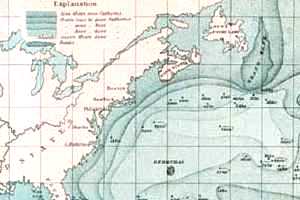Grand Banks
The Grand Banks are a group of underwater plateaus southeast of Newfoundland on the North American continental shelf. These areas are relatively shallow, ranging from 25 to 100 metres in depth. The cold Labrador Current mixes with the warm waters of the Gulf Stream here.
The mixing of these waters and the shape of the ocean bottom lifts nutrients to the surface. These conditions created one of the richest fishing grounds in the world. Fish species include Atlantic cod, haddock and capelin. Shellfish include scallop and lobster. The area also supports large colonies of sea birds such as Northern Gannets, shearwaters and sea ducks and various sea mammals such as seals, dolphins and whales.
In addition to the effects on nutrients, the mixing of the cold and warm currents often causes fog in the area.
History
Several navigators, including Basque fishermen, are known to have fished these waters in the 15th century. In the 15th century some texts refer to a land called Bacalao, the land of the codfish, which is possibly Newfoundland. However, it was not until John Cabot reached the New World in 1497 that the existence of these fishing grounds became generally known in Europe. Ships from France, Spain, Portugal and England came to fish these waters. These fish stocks were also important for the early economies of eastern Canada and New England.
On November 18, 1929, a major earthquake (known as the 1929 Grand Banks earthquake) on the southwestern part of the Grand Banks bordering the Laurentian Channel caused an underwater landslide which resulted in extensive damage to transatlantic cables and generated a rare Atlantic tsunami that struck the south coast of Newfoundland and eastern Cape Breton Island claiming 27 lives in the Burin Peninsula.
Technological advances in fishing such as large factory ships and sonar, as well as geopolitical disputes over territorial sea and exclusive economic zone (EEZ) boundaries, have led to overfishing and a serious decline in the fish stocks of the Grand Banks from around 1990. Fishery-based economy of Newfoundland and Labrador is in a severe crisis from 1990s. Canada's EEZ currently occupies the majority of the Grand Banks except for the lucrative "nose" (eastern extremity, near the Flemish Cap) and "tail" (southern extremity) of the fishing bank. However, the Treaty of Paris (1783) gives the United States shared rights to fish these waters, despite the EEZ.
Canada is currently performing the hydrographic and geological surveys necessary for claiming the entire continental shelf off eastern Canada, under the auspices of the latest United Nations Convention on the Law of the Sea. Once this aspect of UNCLOS is ratified, Canada will presumably control these remaining parts of Grand Banks which are outside of its EEZ jurisdiction.
Petroleum reserves have also been discovered and a number of oil fields are under development in this region, most notably the Hibernia, Terra Nova, and White Rose projects; the harsh environment on the Grand Banks also led to the Ocean Ranger disaster.
Semi-fictional depictions of fishermen working on the Grand Banks can be found in Sebastian Junger's novel The Perfect Storm (1997) and in Rudyard Kipling's novel Captains Courageous (1897).
See also
- Continental shelf
- Turbot War
ReferencesISBN links support NWE through referral fees
- Answers Corporation. Grand Banks Retrieved June 6, 2008.
- Bradley, W. P. (1969). They live by the wind; the lore and romance of the last sailing workboats: the Grand Banks schooners, the square-rigged training ships, the Chesapeake oysterboats, the fishing sloops of the Bahamas. New York: Knopf.
- Greenpeace. History of the Grand Banks Cod Fishery Retrieved June 6, 2008.
- Hiscott, Richard N., and Andrew J. Pulham. 2005. Petroleum resources and reservoirs of the Grand Banks, eastern Canadian margin. Geological Association of Canada special paper, 43. St. John's, N.L.: Geological Association of Canada. ISBN 9780919216822
- Kurlansky, Mark. 1997. Cod: a biography of the fish that changed the world. New York: Walker and Co. ISBN 9780802713261
- The Columbia Gazetteer of North America. Grand Banks Retrieved June 6, 2008.
External links
All Links Retrieved June 6, 2008.
- Overfishing:The Grand Banks and the Flemish Cap
- Government response to the standing committee on fisheries and oceans' tenth report
Credits
New World Encyclopedia writers and editors rewrote and completed the Wikipedia article in accordance with New World Encyclopedia standards. This article abides by terms of the Creative Commons CC-by-sa 3.0 License (CC-by-sa), which may be used and disseminated with proper attribution. Credit is due under the terms of this license that can reference both the New World Encyclopedia contributors and the selfless volunteer contributors of the Wikimedia Foundation. To cite this article click here for a list of acceptable citing formats.The history of earlier contributions by wikipedians is accessible to researchers here:
The history of this article since it was imported to New World Encyclopedia:
Note: Some restrictions may apply to use of individual images which are separately licensed.

